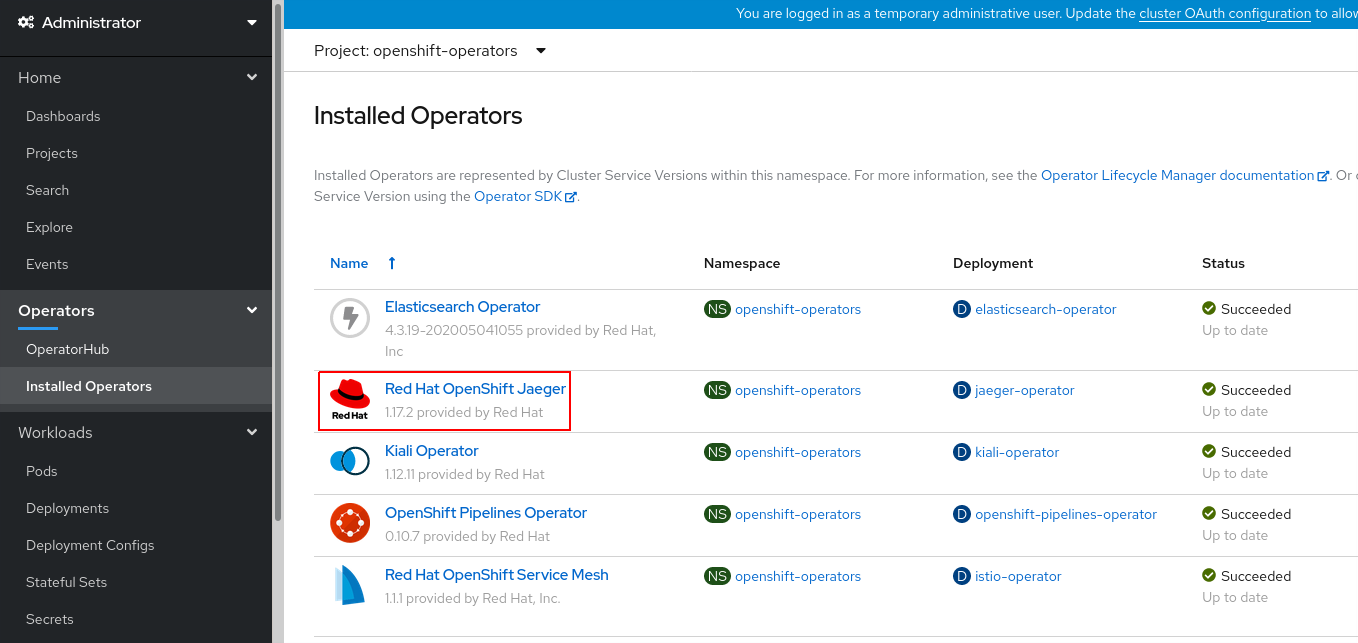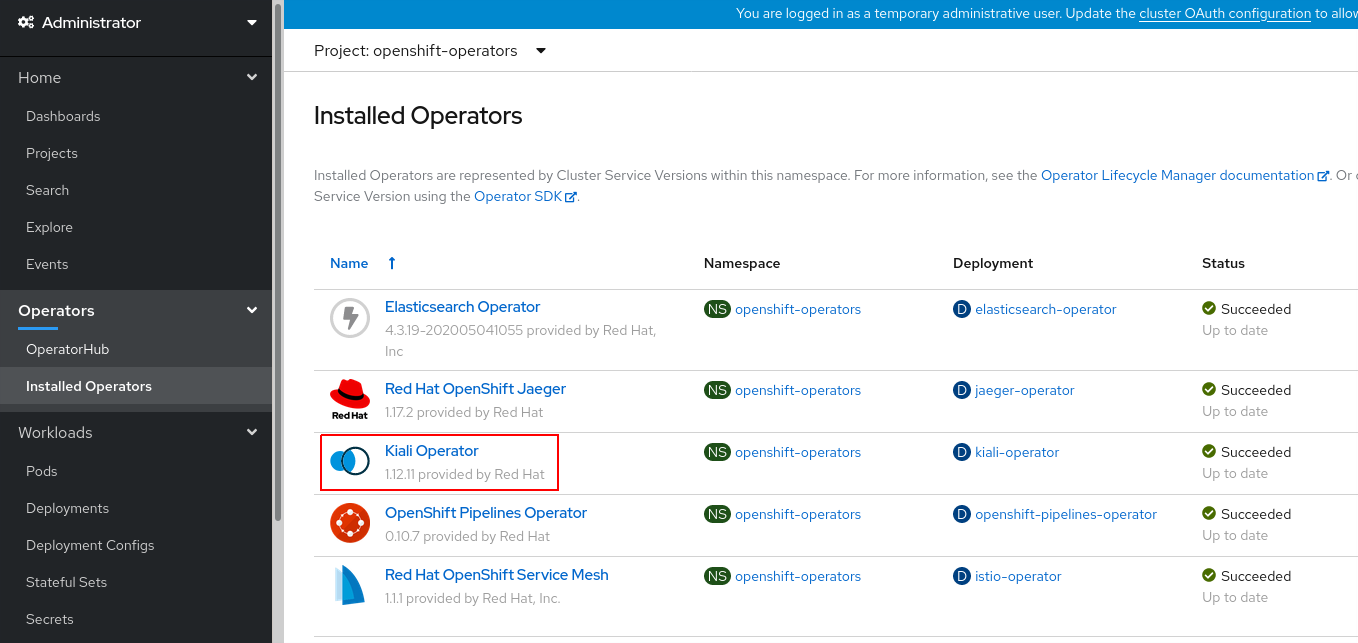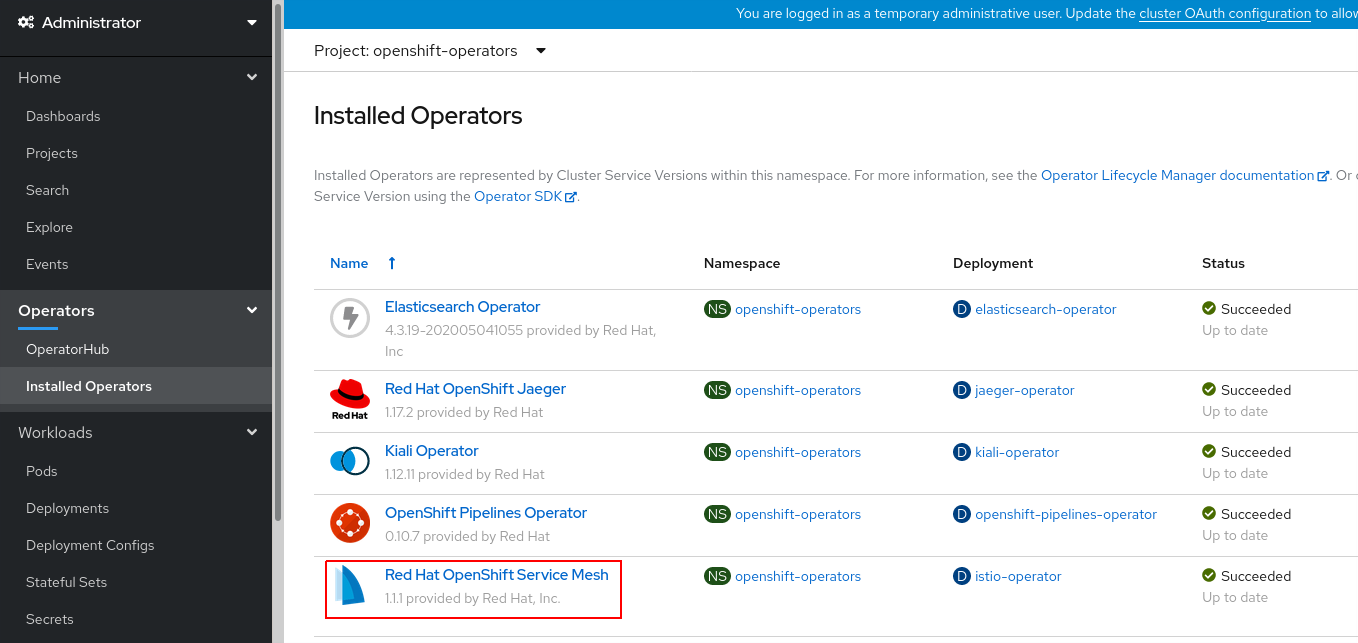Service Mesh Installation
How to install Service Mesh easy, straight forward and with a basic but fully operational installation on top of OpenShift 4? And how are the advantages and caveats of each configuration parameter?
I been playing with Service Mesh more than 1 year in this moments. I tweaked, broke it a lot of times, tried with different configurations and after a bit off playing with other things, I wanted to write some blog post with all the things that I discovered.
This is a blog post series (I hope :D), that involves all of the configurations, tools, components, pros/cons about this wonderful world of the Service Mesh.
All of the blog post will be about Service Mesh on top of OpenShift, but as you know you can deploy very easily the exact examples in Kubernetes.
So, let’s start!
Overview
Installing the Service Mesh involves :
-
Installing Elasticsearch, Jaeger, Kiali
-
Installing the Service Mesh Operator
-
Creating and managing a ServiceMeshControlPlane resource to deploy the Service Mesh control plane
-
Creating a ServiceMeshMemberRoll resource to specify the namespaces associated with the Service Mesh.
NOTE: this blog post is supported by the istio-files repository located in my personal Github
1. Installing the Service Mesh Operators from OperatorHub
The Red Hat OpenShift Service Mesh Operator has dependencies Elasticsearch, Jaeger and Kiali operators.
Check the Service Mesh Installation in OpenShift4 of the official documentation of OpenShift and install
1.1 Installing the Elasticsearch Operator
- In the OperatorHub catalog of your OCP Web Console, type Elasticsearch into the filter box to locate the Elasticsearch Operator.
- Check the Elasticsearch operators installation
$ oc get subscription -n openshift-operators | grep "^elastic"
elasticsearch-operator elasticsearch-operator redhat-operators 4.3
$ oc get clusterserviceversion -n openshift-operators | grep "^elastic"
elasticsearch-operator.4.3.14-202004200457 Elasticsearch Operator 4.3.14-202004200457 Succeeded
1.2 Installing Jaeger Operator
- In the OperatorHub catalog of your OCP Web Console, type Jaeger into the filter box to locate the Elasticsearch Operator.
- Check the Jaeger operators installation
$ oc get subscription -n openshift-operators | grep "^jaeger"
jaeger-product jaeger-product redhat-operators stable
$ oc get clusterserviceversion -n openshift-operators | grep "^elastic"
jaeger-operator.v1.17.2 Red Hat OpenShift Jaeger 1.17.2 Succeeded
1.3 Installing the Kiali Operator
- In the OperatorHub catalog of your OCP Web Console, type Kiali Operator into the filter box to locate the Elasticsearch Operator.
- Check the Kiali operators installation
1.4 Installing Service Mesh Operators
- In the OperatorHub catalog of your OCP Web Console, type ServiceMesh Operator into the filter box to locate the Elasticsearch Operator.
- Check the Service mesh operators installation
$ oc get subscription -n openshift-operators | grep "^servicemesh"
servicemeshoperator servicemeshoperator redhat-operators stable
$ oc get clusterserviceversion -n openshift-operators | grep "^servicemesh"
servicemeshoperator.v1.1.1 Red Hat OpenShift Service Mesh 1.1.1 servicemeshoperator.v1.1.0 Succeeded
1.5 Check that all the mesh operators are installed
Finally, check that the operators involved in the Service Mesh installation are installed properly:
$ oc get subscription -n openshift-operators
NAMESPACE NAME PACKAGE SOURCE CHANNEL
openshift-operators elasticsearch-operator elasticsearch-operator redhat-operators 4.3
openshift-operators jaeger-product jaeger-product redhat-operators stable
openshift-operators kiali-ossm kiali-ossm redhat-operators stable
openshift-operators openshift-pipelines-operator openshift-pipelines-operator community-operators dev-preview
On the other hand, you can check the installation with the ClusterServiceVersion custom resource:
$ oc get ClusterServiceVersion
NAME DISPLAY VERSION REPLACES PHASE
elasticsearch-operator.4.3.14-202004200457 Elasticsearch Operator 4.3.14-202004200457 Succeeded
jaeger-operator.v1.17.2 Red Hat OpenShift Jaeger 1.17.2 Succeeded
kiali-operator.v1.12.11 Kiali Operator 1.12.11 kiali-operator.v1.12.7 Succeeded
servicemeshoperator.v1.1.1 Red Hat OpenShift Service Mesh 1.1.1 servicemeshoperator.v1.1.0 Succeeded
2. Installing ServiceMesh Control Plane and Service Mesh Member Role
The previously installed Service Mesh operator watches for a ServiceMeshControlPlane resource in all namespaces. Based on the configurations defined in that ServiceMeshControlPlane, the operator creates the Service Mesh control plane.
2.1 Create istio-system namespace
Create a namespace called istio-system where the Service Mesh control plane will be installed.
$ cat istio-files/mesh-install/servicemesh-namespace.yml
apiVersion: project.openshift.io/v1
kind: Project
metadata:
name: istio-system
spec:
finalizers:
- kubernetes
$ oc apply -f istio-files/mesh-install/servicemesh-namespace.yml
2.2 Deploy Service Mesh Control Plane
Let’s dig in in the installation of a Service Mesh Control Plane, once we have the operators in place, and the namespace for the installation of the mesh deployed:
The file of the basic-istio-install.yaml contains the description of a basic mesh installation with the configuration of all of the components involved (a bit tweaked):
$ cat istio-files/mesh-install/basic-istio-install.yml
apiVersion: maistra.io/v1
kind: ServiceMeshControlPlane
metadata:
name: basic-install
namespace: istio-system-$NAMESPACE
spec:
istio:
global:
controlPlaneSecurityEnabled: true
disablePolicyChecks: false
mtls:
enabled: true
proxy:
accessLogFile: /dev/stdout
sidecarInjectorWebhook:
rewriteAppHTTPProbe: true
gateways:
istio-egressgateway:
autoscaleEnabled: false
istio-ingressgateway:
autoscaleEnabled: false
mixer:
policy:
autoscaleEnabled: false
telemetry:
autoscaleEnabled: false
pilot:
autoscaleEnabled: false
traceSampling: 100
kiali:
enabled: true
grafana:
enabled: true
tracing:
enabled: true
jaeger:
template: all-in-one
---
apiVersion: maistra.io/v1
kind: ServiceMeshMemberRoll
metadata:
name: default
namespace: istio-system-$NAMESPACE
spec:
members:
- $NAMESPACE
NOTES:
- Mutual TLS is enabled by setting mtls to true.
- Kiali and grafana are enabled
- Mixer (policy and telemetry) have autoscaleEnabled disabled
- Gateway (ingress and egress) have autoscaleEnabled disabled
- RewriteAppHTTProbe set to true
- Jaeger is enabled with the template of all-in-one
Apply the basic Service Mesh Control Plane:
$ cat istio-files/mesh-install/basic-istio-install.yml | NAMESPACE=$OCP_NS envsubst | oc apply -f -
servicemeshcontrolplane.maistra.io/basic-install created
servicemeshmemberroll.maistra.io/default created
After a bit, check that the control plane is installed properly:
$ oc get pod -n istio-system
NAME READY STATUS RESTARTS AGE
grafana-67c58f9f9-2czv8 2/2 Running 0 3m33s
istio-citadel-6784798885-2hmwt 1/1 Running 0 5m21s
istio-egressgateway-659bb7c7db-xtmj9 1/1 Running 0 4m8s
istio-galley-5988bb6f9c-88tzf 1/1 Running 0 4m24s
istio-ingressgateway-569c9555db-ptpq6 1/1 Running 0 4m8s
istio-pilot-5fff54b8cc-dt54j 2/2 Running 0 4m8s
istio-policy-7f4dbcc979-cjfhh 2/2 Running 0 4m13s
istio-sidecar-injector-866fccd4d9-24t9b 1/1 Running 0 3m49s
istio-telemetry-7dc77c4d8b-9r7p9 2/2 Running 0 4m13s
jaeger-6cfd8f88bf-5ffmc 2/2 Running 0 4m24s
kiali-599499888b-cxz9w 1/1 Running 0 2m33s
prometheus-6886c768dc-886s9 2/2 Running 0 5m10s
The Service Mesh operator has installed a control plane configured for multitenancy. This installation reduces the scope of the control plane to only those projects/namespaces listed in a ServiceMeshMemberRoll.
$ oc get smmr -o yaml
apiVersion: maistra.io/v1
kind: ServiceMeshMemberRoll
metadata:
name: default
namespace: istio-system
spec:
members:
- istio-tutorial
NOTE: if you want to add more namespaces inside of the mesh, add the namespaces in the members list inside of the smmr.
Links
Check the Service Mesh Installation in OpenShift4 of the official documentation of OpenShift for more information.
Check out the part two of this blog series in Microservices deployment in Service Mesh
NOTE: Opinions expressed in this blog are my own and do not necessarily reflect that of the company I work for.
Happy ServiceMeshing!!





